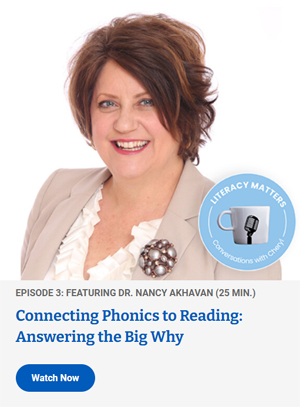Not only is it vital that students understand how to say the words on the page, but it’s also equally as important that they understand the meaning behind those very words. This dichotomy unveils the bigger picture when transforming students into successful readers and writers.
In the latest episode of Literacy Matters, Dr. Nancy Akhavan shows us how to effectively fuse both concepts with her expertly crafted formula—the “Lit 6”.

With over 30 years of literacy experience as an educator, author, and speaker, Dr. Akhavan will introduce you to some of the elements from the formula and help give purpose to your phonics instruction. Read on for the first three elements in her Lit 6 formula:
1 – Read Alouds
By implementing read-alouds in your day-to-day instruction, students develop listening comprehension skills that scaffold into much-needed decoding skills. Teachers control the reading, which allows students to purely focus on understanding the audible text.
2 – Shared Reading
Shared readings work as an extension to read-aloud sessions. As the name suggests, students read along with the instructor. Students can see the words and start building visual connections to the associated sounds.
3 – Small Group Reading
Also known as “guided reading”, this allows students to practice independence. Students can form small groups, pairs, or even work individually and work on interpreting the text by themselves. As students gradually gain experience with some of these activities, they progress from simply decoding words to fully comprehending language.
When implementing these elements into your classroom, you can further benefit from understanding the guiding principles that helped form the “Lit 6” formula.
Scarborough’s Reading Rope
This conceptual rope defines the intertwining relationship between language comprehension and word recognition. As students hone their skills in vocabulary, language structures, and phonological awareness, they create the foundational guiding strand that leads to skilled reading.
Rosenblatt’s Reader Response Theory
Through lived experience, each student arrives to class with a unique perspective that affects how they interpret the text. Whether they come from a different ethnic, geographic, or social background, these factors breathe distinct life into the meaning behind the reading.
Even doing so much as simply talking to students can be enough to get the gears shifting. Students that are naturally exposed to more advanced vocabulary through daily conversation can experience a greater level of reading comprehension in the classroom.
Learning Without Tears is committed to helping you become the literacy heroes your students need. By partnering with experts in the field, Literacy Matters is diving deep to explore the tips, tricks, and resources that make a world of difference in and out of the classroom.
To learn more about the final elements of the “Lit 6” formula and explore the principles backed by Dr. Akhavan, watch the full episode of Literacy Matters, hosted by Cheryl Lundy Swift.